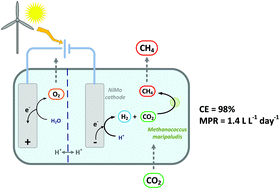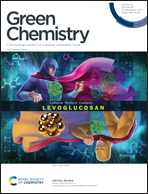In situ electrochemical H2 production for efficient and stable power-to-gas electromethanogenesis†
Abstract
Bioelectrochemical power-to-gas presents a promising technology for long-term storage of excess renewable energy in the form of methane. The transition of the technology from laboratory to applied scale is currently challenged by low volumetric production rates, energy losses at the cathode, as well as the unknown physiology of the microbes in an electrochemical reactor. Here, we introduce a stable electromethanogenesis system based on efficient in situ hydrogen production by non-precious-metal catalysts and effective hydrogen uptake by the methanogenic microorganisms. Using NiMo-cathodes and pure cultures of hydrogenotrophic Methanococcus maripaludis, our system achieved an unprecedented volumetric methane production rate from CO2 of 1.4 L methane per L per day. The system performed stably for over 4 weeks with columbic efficiencies steadily above 90%. A physiological analysis of cells in the electromethanogenic reactor revealed robustly-growing cells with nearly identical protein expression patterns to gas-fed controls. Local pH fluctuations at the surface of cathode and cation exchange membrane resulted in a small but noticeable fraction of cell lysis. Our data collectively indicate that physiologically uncompromised cells of a pure methanogenic culture can perform methanogenesis robustly at high specific rate in a biocompatible electromethanogenic reactor using inexpensive, earth-abundant cathode materials.



 Please wait while we load your content...
Please wait while we load your content...